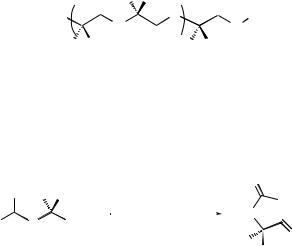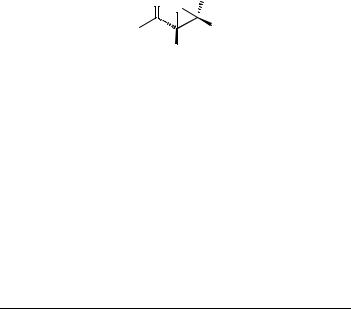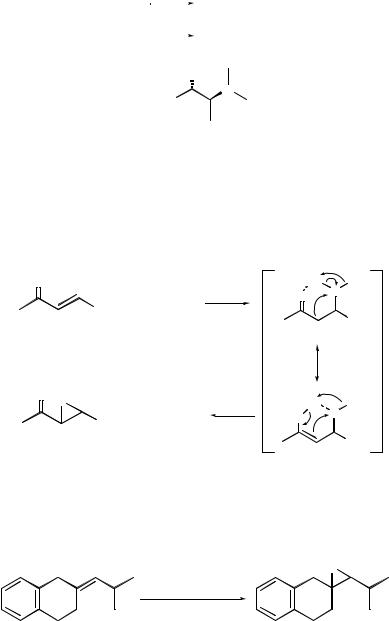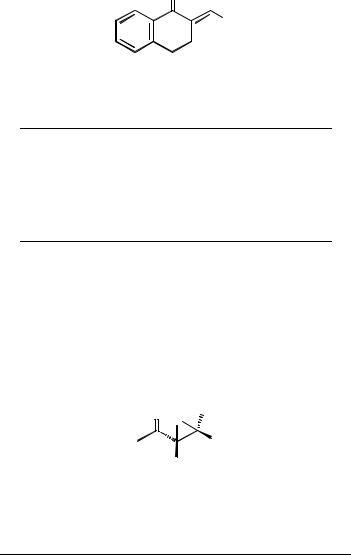
Roberts S.M., Poignant G. - Catalysts for fine chemical synthesis (Vol.1) (2002)(en)
.pdf
epoxidation of a,b-unsaturated carbonyl compounds |
57 |
|||||||||||
O |
R H |
H |
O |
|
||||||||
|
|
|
|
|
|
|
|
|
|
|
|
|
H2N |
|
|
N |
|
|
|
N |
|
|
|
R' |
|
|
|
|
|
|
|
|
|
|||||
|
|
|
|
|
|
n |
|
|
|
N |
|
|
|
|
|
H |
O |
|
|
|
|
H |
|
||
H R |
|
H |
R |
|
||||||||
|
|
|
|
|
|
|
|
|
|
|
n=10 |
|
R = CH2-CH(CH3)2 |
R' = polystyrene |
|
||||||||||
Figure 4.2 Immobilized poly-d-leucine catalyst.
4.2.1SYNTHESIS OF LEUCINE N-CARBOXYANHYDRIDE
|
|
|
|
|
|
|
|
O |
|
|
|
|
CH3 H |
NH2 |
1/ |
3 |
Cl3COC(O)OCCl3 |
|
|
O |
|||
H3C |
|
C |
COOH |
|
|
|
|
HN |
|
|
|
|
|
|
|
THF,65 8C |
|
|
|
||||
|
|
|
|
|
|
|
|
||||
|
|
H2 |
|
|
|
|
|
H |
|
|
O |
|
|
|
|
|
|
|
|
|
CH2-CH(CH3)2 |
||
Materials and equipment
. d-Leucine, 7.00g, 53.4mmol
. Dry tetrahydrofuran, 115mL
. Triphosgene, 6.34g, 21.4mmol
. n-Hexane (800mL), diethyl ether (100mL)
. Celite1
. Silica gel 60 (0.063±0.04mm)
. Sand
. 250mL Two-necked and 500mL round-bottomed flask with magnetic stirrer bars
. Magnetic stirrer
. Reflux condenser
. Magnetic stirrer with thermostatically controlled oil bath and thermometer
. Glass sintered funnel, diameter 5.5cm
. Rotary evaporator
Procedure
1.The 250mL round-bottomed flask, equipped with a magnetic stirrer bar, was dried in an oven at 120 8C for 4 hours. The flask was removed, sealed, cooled under vacuum and flushed with nitrogen.
2.d-Leucine (7.00g) was placed in the flask and vacuum was applied to the system. The flask was flushed with nitrogen for 1 hour and equipped with a reflux condenser. Tetrahydrofuran (85mL) was added and the mixture heated to a gentle reflux (b.p. 65±678C).

58 |
hydrolysis, oxidation and reduction |
.The solution remained cloudy due to the insolubility of D-leucine even when heated in tetrahydrofuran.
3.When the mixture was refluxing, the triphosgene (5.81 g) was added carefully, portionwise over 5 minutes. The mixture was heated for 1 hour.
Triphosgene is very toxic. Wear suitable gloves, and eye and face protection. Handle very carefully in a well-ventilated fume-hood.
The mixture gradually became clearer as the insoluble material was consumed. If the mixture is not clear after 1 hour continue heating for another 20 minutes. If the mixture at this stage remained unclear, 0.53 g of triphosgene was added and heated further.
4.Once the clear mixture had cooled to room temperature, it was then poured into a 500 mL round-bottomed flask containing n-hexane (400 mL).
5. A sintered glass funnel was packed with 2 cm Celite1, 1 cm silica gel and 3 cm sand. The n-hexane solution was carefully filtered through this packed funnel without disturbing the packing material. The filtration was completed by rinsing the packing with diethyl ether (100 mL).
6. The solvent was removed from the filtrate using a rotary evaporator to afford a white solid. Dry tetrahydrofuran (30 mL) was added to dissolve the solid and then n-hexane was added until a white solid precipitated.
Approximately 400 mL of n-hexane was necessary to precipitate the product.
7.The solution was filtered and the resulting white solid was dried under high vacuum. This provided leucine N-carboxyanhydride (6.7 g, 80 %); m.p.
76±77 8C, (Lit.[2] 77±79 8C).
This procedure had been scaled up to provide 50 g of the N-carboxyan- hydride.
4.2.2SYNTHESIS OF IMMOBILIZED POLY-d-LEUCINE
O |
|
|
O |
R H |
|
O |
|
||||||||||
|
|
|
|
|
H |
|
|||||||||||
|
O |
|
CLAMPS |
H2N |
|
|
|
|
|
|
|
|
|
|
|
||
|
|
|
|
N |
|
|
|
|
N |
|
|
|
R' |
||||
n HN |
|
|
|
|
|
|
|
|
|
|
n |
|
|
|
N |
||
|
|
|
|
|
|
|
|
|
|
|
|
|
|||||
|
|
|
|
THF |
H R |
|
|
H |
|
O |
H |
R |
H |
||||
H |
|
|
O |
|
|
|
|
n=10 |
|||||||||
|
|
|
|
|
|
|
|
|
|||||||||
|
|
|
|
|
|
|
|
|
|
|
|
|
|
|
|||
CH2 - CH(CH3)2 |
R=CH |
- CH(CH |
) |
2 |
|
|
R' = polystyrene |
||||||||||
|
|
|
|
|
2 |
|
|
3 |
|
|
|
|
|
|
|
|
|
Materials and equipment
. Tetrahydrofuran, 110 mL
. N-Carboxyanhydride
. Cross-linked aminomethylpolystyrene (CLAMPS), 500 mg[3, 4]
. Acetone±distilled water (1:1), 50 mL

epoxidation of a, b-unsaturated carbonyl compounds |
59 |
. Acetone±distilled water (4:1), 50 mL
.Diethyl ether (50 mL), acetone (100 mL), ethyl acetate (50 mL), petroleum ether (50 mL)
. 250 mL Round-bottomed flask with a magnetic stirrer bar
. Magnetic stirrer
Procedure
1.The N-carboxyanhydride was placed in a 250 mL round-bottomed flask equipped with a magnetic stirrer bar, under nitrogen. Dry tetrahydrofuran (110 mL) was then added followed by cross-linked aminomethylpolystyrene. The mixture was stirred for 4 days.
2.The solution was filtered, diethyl ether (50 mL) was added to the solid and collected on the filter. The solid was left to soak in the diethyl ether for 30 minutes before removing the solvent by aid of a water aspirator. This procedure of soaking the solid on the filter was repeated with acetone±distilled water (1:1), acetone±distilled water (4:1), acetone (2 50 mL), ethyl acetate (50 mL) and petroleum ether (50 mL).
3.The white solid was placed under high vacuum overnight to give immobilized poly-d-leucine (4.4 g) as a white powder.
The quality of the catalyst can be determined by performing an asymmetric epoxidation reaction on chalcone according to the following procedure. The activity of the polymer was considered satisfactory if it provided the epoxy-chalcone in 85 % yield and 95 % of enantiomeric excess, with a reaction time between 10 and 40 minutes.
4.2.3 ASYMMETRIC EPOXIDATION OF (E)- BENZYLIDENEACETOPHENONE
O |
H |
O |
|
||
Poly - D -leucine |
|
O |
UHP, DBU, THF |
|
|
|
|
H |
|
|
(2S,3R) |
Materials and equipment
. Anhydrous tetrahydrofuran, 0.8 mL
. Chalcone (E)-benzylideneacetophenone (97 %), 50 mg, 0.24 mmol
. Poly-d-leucine, 100 mg
. Urea±hydrogen peroxide (UHP, 98 %), 27 mg, 0.28 mmol
60 |
hydrolysis, oxidation and reduction |
. |
1,8-Diazabicyclo[5.4.0]undec-7-ene (DBU, 98 %) three drops, 90 mg, |
32 mmol
. Ethyl acetate, petroleum ether
. Brine
. Magnesium sulfate
. Two 10 mL round-bottomed flasks with magnetic stirrer bars
. Magnetic stirrer
. BuÈchner funnel (5 cm)
. BuÈchner flask
. Filter paper
. Separating funnel, 250 mL
. Rotary evaporator
Procedure
1. In a 10 mL round-bottomed flask equipped with a magnetic stirrer bar
were placed tetrahydrofuran (0.8 mL) |
and immobilized poly-d-leucine |
(100 mg). (E)-Benzylideneacetophenone |
(50 mg), 1,8-diazabicyclo[5.4.0] |
undec-7-ene (90 mg), and urea±hydrogen peroxide (27 mg) were added to the mixture. The thick white reaction mixture was stirred vigorously for 30 minutes.
2.The reaction was monitored by TLC (eluent: petroleum ether±ethyl acetate, 4:1). Visualized by p-anisaldehyde dip, the chalcone stained brown, Rf 0.42 and the epoxide stained blue, Rf 0.36.
3.After completion, the mixture was poured into ethyl acetate and the catalyst was removed by filtration using two filter papers in a BuÈchner funnel. The poly-d-leucine residue was washed with ethyl acetate (2 10 mL), with water (2 10 mL) and with brine (10 mL).
4.The mixture was transferred into a separating funnel and the phases were separated. The aqueous layer was extracted with ethyl acetate (3 20 mL). The combined organic layers were dried over magnesium sulfate, filtered and concentrated using a rotary evaporator to give a crystalline solid (2S,3R)-epoxychalcone (90 %).
The ee (95±99 %) was determined by HPLC (Chiralpak1 AD column, flow 1 mL/min, eluent ethanol±n-hexane 1:9); (2R,3S)-enantiomer: Rt 13.6 min, (2S,3R)-enantiomer: Rt 20.5 min.
1H NMR (200 MHz, CDCl3): d 7.3±7.6, 7.9±8.0 (2m, 10H, Ph); 4.24 (d, J 2.0 Hz, 1H, Ha ); 4.02 (d, J 2.0 Hz, 1H, Hb ).
IR (CHCl3, cmÿ1): 3069 (C±H epoxide), 3012, (C±H aromatic), 2965, 1692 (CˆO), 1599, 1581, 1450 (CˆC), 1406 (C±C aromatic), 1260, 1203 (C±O±C), 1098, 1009, 884.

epoxidation of a, b-unsaturated carbonyl compounds |
61 |
4.2.4CONCLUSION
The validation was performed without any modifications. The procedure is very easy to reproduce and the achieved results correlate with the published material. The yield is somewhat lower than the published result, though monitoring of the reaction by TLC indicated complete consumption of substrate. This is believed to be due to decreased precipitation during recrystallization. Because the product is unstable in solution it is recommended that the recrystallization is performed as quickly as possible. Alternatively, the impurities can be removed by trituration.
The asymmetric epoxidation reaction with polyleucine as catalyst may be applied to a wide range of a, b-unsaturated ketones. Table 4.1 shows different chalcone derivatives that can be epoxidized with poly-l-leucine. The substrate range included dienes and tetraenes[5]. Some other examples were reported in a previous edition[6] and by M. Lasterra-SaÂnchez[7].
|
O |
H |
|
O |
|
|
|
|
R1 |
|
R2 |
|
|
H |
4.3 ASYMMETRIC EPOXIDATION USING CHIRAL MODIFIED
DIETHYLZINC[8]
The epoxidation of enones with poly-d-leucine is complementary to other strategies. Enders et al.[8] introduced a new method for the asymmetric epoxidation of a-enones using diethylzinc, oxygen and (1R, 1R)-or (1S, 2S)-N- methylpseudoephedrine as chiral auxiliary.
The mechanism of this `one-pot reaction' is proposed to be as follows (Figure 4.3); firstly, a chiral alkoxide ethylzinc is prepared from diethylzinc and the chiral alcohol with the evolution of a gas, which is probably ethane (I). The chiral ethylperoxyzinc alkoxide is formed by insertion of oxygen into the carbon±zinc
Table 4.1 Epoxidation of enones using poly-l-leucine catalyst[5,7].
R1 |
R2 |
Yield% |
ee% |
|
|
|
|
t-Bu |
Ph |
92 |
>98 (2R,3S) |
i-Pr |
Ph |
60 |
62 (2R,3S) |
Cyclopropyl |
Ph |
85 |
77 (2R,3S) |
2-Naphthyl |
Cyclopropyl |
73 |
>98 (2R,3S) |
2-Naphthyl |
Ph±CHˆCH |
78 |
>96 (2R,3S) |
|
|
|
|

62 |
hydrolysis, oxidation and reduction |
|
|||||||
bond (II). This species represents an |
asymmetric |
epoxidizing |
reagent for |
||||||
a, |
b-unsaturated ketones. |
|
|
|
|||||
|
Et2Zn + |
R*OH |
|
|
|
EtZnOR* |
+ EtH |
(I) |
|
|
|
|
|||||||
|
EtZnOR* |
+ O2 |
|
|
EtOOZnOR* |
(II) |
|||
|
|
||||||||
OH
R*OH(1S,2S): N
Ph
Figure 4.3 Formation of the active species in the epoxidation reaction using diethylzinc and (1S, 2S)-methylpseudoephedrine.
In the epoxidation process (Figure 4.4), the oxygen of the enone's carbonyl function first coordinates with the zinc atom. The ethylperoxy anion then attacks the b-position, which constitutes a Michael-type addition. The subsequent cyclization gives the epoxy ketone and the zinc alkoxide.
O |
R*OZn |
OEt |
|
|
+ EtOOZnOR* |
O |
O + |
R1 |
|
|
|
R2 |
|
|
|
|
R1 |
- |
R2 |
|
O |
O |
|
R*OZn |
OEt |
|
|
* |
|||
|
|
|
|
O |
|
|
|
|
+ R*OZnOEt |
O |
|
R1 |
|
* |
R2 |
|
|
|
|
|
R1 |
R2 |
|
|
|
|
|
Figure 4.4 Mechanism of epoxidation using diethylzinc and methylpseudoephedrine.
4.3.1EPOXIDATION OF 2-ISOBUTYLIDENE-1-TETRALONE
O |
O |
O |
||||
|
|
|
|
|
|
|
|
|
|
|
|
|
|
Et2Zn, (S,S)R*OH,O2
Toluene,0 8C
(2S, 3R)
epoxidation of a, b-unsaturated carbonyl compounds |
63 |
Materials and equipment
. (1S,2S)-N-Methylpseudoephedrine, 430mg, 2.4mmol, 2.4eq
. Anhydrous toluene, 12mL
. Diethylzinc solution, 1.1 M in toluene, 1mL, 1.1mmol, 1.1eq
Diethylzinc is flammable, reacts with water and can cause severe burns. Wear gloves and eye protection, and handle with care.
If low yield and/or enantiomeric excess is obtained, the purity of the diethylzinc should be the primary suspect.
. Oxygen gas
. 2-Isobutylidene-1-tetralone, 200mg, 1mmol
This substrate was prepared by aldol condensation of tetralone with isobutyraldehyde in the presence of aqueous sodium hydroxide[9].
. Aqueous phosphate buffer solution pH 7, 8mL
. Dichloromethane, petroleum ether, diethyl ether, n-hexane
. Brine
. Sodium sulfate
. Silica gel 60 (0.063±0.04mm)
. p-Anisaldehyde
. 50mL Two-necked dry flask with a magnetic stirrer bar
. Magnetic stirrer
. Acetone cooling bath equipped with a contact thermometer, 08C
. Syringes
. Balloon equipped with a syringe
. Ice-bath
. Separating funnel, 250mL
. Rotary evaporator
Procedure
1.A 50mL two-necked flask, equipped with a magnetic stirrer bar, was placed in an oven at 1208C for 4 hours. The flask was removed, cooled under vacuum and flushed with nitrogen.
2.Inthedryflaskwas dissolved (1S,2 S)-N-methylpseudoephedrine (430mg) in anhydroustoluene(10mL)underargon. Thereactionmixturewasplacedina cooling bath equipped with a contact thermometer stirred and cooled to 0 8C. Diethylzinc (1mL) was added carefully via a syringe (evolution of ethane).
3.After 80 minutes the connection with argon was replaced by a balloon filled with oxygen. The reaction mixture was stirred for 2.5 hours without removing the balloon filled with oxygen.
4.The bath was cooled to ÿ788C and a solution of 2-isobutylidene-1-tetralone (200mg) in anhydrous toluene (2mL) was added via a syringe to the cold mixture. The reaction mixture was stirred at this temperature for 30 minutes
64 |
hydrolysis, oxidation and reduction |
and then rapidly warmed to 0 8C by means of an ice-bath while stirring was continued.
5.The reaction was monitored by TLC (eluent: n-hexane±diethyl ether, 8:2). 2-Isobutylidene-1-tetralone (UV active) stained light purple with p-anisalde- hyde dip, Rf 0.66 and the epoxide (UV active) dark purple, Rf 0.30.
6.The reaction was quenched after 16 hours by addition of aqueous phosphate buffer solution (pH 7, 8 mL).
It is recommended to replace the oxygen balloon for an argon balloon after 3.5 hours; extensive exposure to O2 can have an adverse influence on the reaction.
7.The reaction mixture was transferred into a separating funnel and the two layers were separated. The upper aqueous layer was extracted with dichloromethane (3 30 mL). The combined organic layers were washed with brine, dried over sodium sulfate and the solvent was evaporated under reduced pressure.
8.The residue was purified by flash chromatography using petroleum ether±
diethyl ether (9:1) as eluent to give (2S, 30R)-1,2,3,4-tetrahydro-30-isopropyl- spiro [naphthalene-2,20-oxirane]-1-one as a yellow oil (190 mg, 0.88 mmol, 90 %).
The ee (>99 %) was determined by HPLC (Chiralpak1 AD column, flow 1 mL/min, ethanol±n-hexane; 1:9); (2S, 30R)-enantiomer: Rt 8.84 min, (2R, 30S)-enantiomer: Rt 7.02 min.
1H NMR (200 MHz, CDCl3): d 8.09 (dd, J 7.7 Hz, J 1.1 Hz, 1H, COCCH); 7.54 (td, J 7.4 Hz, J 1.6 Hz, 1H, COCCHCH); 7.34 (m, 1H, CH2CCHCH); 3.15 (dd, J 8.2 Hz, J 4.4 Hz, 2H, COCCH2CH2); 3.00 (d, J 9.3 Hz, 1H, CH3CHCH); 2.50 (dt, J 13.7 Hz, J 8.4 Hz, 1H, COCCH2); 2.14 (dt, J 13.7 Hz, J 4.7 Hz, 1H, COCCH2); 1.68 (m, 1H, CH(CH3)2†; 1.2 (d, J 6.6 Hz, 3H, CH3); 2.06 (d, J 6.6 Hz, 3H, CH3).
IR (CHCl3, cmÿ1): 3009 (C±H aromatic), 2972, 2935, 2873 (C±H aliphatic), 1687 (C ˆ O), 1604 (C±C aromatic), 1469, 1457, 1433 (CH2, CH3), 1316, 1304, 1203 (C±O±C), 1158, 925, 893, 878, 844, 822.
Mass: calculated for C14H16O2: m/z 216.11502; found [M]‡ 216.11520.
4.3.2CONCLUSION
Ender's method is easy to reproduce; however, it needs a freshly prepared diethylzinc solution as its quality can dramatically influence the enantiomeric excess. Strictly, the reaction is not a catalytic process but the methylpseudoephedrine (chiral auxiliary) can be recovered almost completely with unchanged enantiomeric purity during the flash chromatography. This method gives good results for epoxidation of a-enones such as (E)-2-alkyliden-1-oxo-1,2,3,4-tetra- hydronaphthalene. The enantiomeric excess obtained during the validation correlates with the published result. Table 4.2 gives the results obtained by the method described above, according to the relevant publication.

epoxidation of a, b-unsaturated carbonyl compounds |
65 |
O
R1
Table 4.2 a,b-Epoxy ketones prepared by epoxidation of (E)-2-alkyliden-1-oxo-1,2,3,4-tetrahydronaphthalenes using diethylzinc and (1R,2R)-N-methylpseudoephedrine[8].
R1 |
Yield % |
ee % |
H |
40 |
3 |
Me |
85 |
80 |
Et |
65 |
90 |
i-Pr |
98* |
>99* |
n-Pr |
99 |
83 |
Ph |
62 |
64 |
*Reaction validated
For epoxidation of chalcones using Ender's method, the results depend on the nature of the substrate. For the (E)-benzylideneacetophenone (R1, R2 ˆ Ph), the enantiomeric excess was only 60 % using the same procedure as the one described above, whereas the polyleucine method furnished the epoxide with an enantiomeric excess > 95 %. Table 4.3 gives some results of the epoxidation of some acyclic enones using Ender's method.
|
O |
H |
|
O |
|
|
|
|
R1 |
|
R2 |
|
|
H |
Table 4.3 a, b-Epoxy ketones prepared by epoxidation of a-enones using diethylzinc and (1R, 2R)-N-methylpseudoephedrine (according to the relevant publication)[8].
R1 |
R2 |
Yield % |
ee % (configuration) |
|
Ph |
Et |
99 |
91 |
(2R,3S) |
Ph |
Me |
96 |
85 |
(2R,3S) |
Ph |
n-Pr |
99 |
87 |
(2R,3S) |
Ph |
i-Pr |
97 |
92 |
(2R,3S) |
Ph |
Ph |
94* |
61 |
(2R,3S)* |
t-Bu |
Ph(CH2)2 |
99 |
90 |
(2R,3S) |
2,4,6-Me3Ph |
Et |
94 |
82 |
(2R,3S) |
* Reaction validated

66 |
hydrolysis, oxidation and reduction |
4.4 ASYMMETRIC EPOXIDATION OF (E )- BENZYLIDENEACETOPHENONE USING THE La-(R)-BINOL-Ph3PO/ CUMENE HYDROPEROXIDE SYSTEM
K. Daikai, M. Kamaura, and J. Inanaga
Institute for Fundamental Research of Organic Chemistry (IPOC), Kyushu University Hakozaki, Fukuoka 812±8581, Japan, e-mail: inanaga@ms.ifoc.kyushu-u.ac.jp
O |
5 mol% La(O-i-Pr)3 |
H |
O |
|
5 mol% (R)-BINOL |
|
O |
|
|
|
15 mol% Ph3PO |
|
|
+ CMHP |
H |
|
MS 4A, THF, rt |
||
|
||
|
(2S, 3R) |
Materials and equipment
. Anhydrous tetrahydrofuran, 3.2 mL
. Chalcone, (E )-benzylideneacetophenone (97 %), 93.5 mg, 0.449 mmol
. (R)-(‡)-1,10-Bi-2-naphthol [(R)-BINOL, 99 %], 6.4 mg, 0.0224 mmol
. Triphenylphosphine oxide (Ph3PO, 99 %), 18.7 mg, 0.0672 mmol
. Triisopropoxylanthanum (La(O±i-Pr)3, 99 %), 7.1 mg, 0.0225 mmol
. Cumene hydroperoxide (CMHP, 99 %), 99.6 mL, 0.673 mmol
Ê
. Molecular sieves 4 A, 44.9 mg
. Ethyl acetate, hexane
. Silica gel
. Celite
. 10 mL Round-bottomed flask with a magnetic stirrer bar
. Magnetic stirrer
. Syringe
. Filter tube
. Rotary evaporator
. Glass column
Procedure
1. In a 10 mL round-bottomed flask equipped with a magnetic stirrer bar were placed activated molecular sieves 4A (44.9 mg), (R)-BINOL (6.4 mg), triphenylphosphine oxide (18.7 mg), and anhydrous tetrahydrofuran (0.9 mL) and the mixture was stirred for 5 minutes under argon. To this suspension was added a suspension of La(O±i-Pr)3 (7.1 mg) in tetrahydrofuran (1.4 mL) by a syringe. After stirring for 1 hour at room temperature, cumene hydro-
